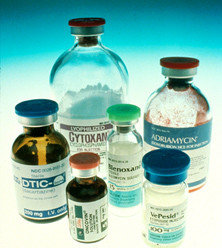Main drugs used in cancer treatment
4,371 viewsThe most widely used anticancer agents in cancer treatment include polyfunctional alkylating, antimetabolites, antitumor antibiotics, mitotic inhibitors and others.

New drugs are continuously being isolated and applied experimentally in animal models before use in humans.
Alkylating
Compounds are able to substitute another molecule in a hydrogen atom by an alkyl radical. They bind to DNA to prevent the separation of the two strands of the double helix DNA spiral, a phenomenon essential for replication. The alkylating affect cells in all phases of the cell cycle in order unspecified.
Although effective as single agents for numerous forms of cancer, they rarely produce good clinical effect without the combination with other agents, phase-specific cell cycle. The main drugs used in this category include nitrogen mustard, mustard phenyl-alanine, cyclophosphamide, busulfan to the nitrosuréias, cisplatin and its análago carboplatin and ifosfamide.
Antimetabolites
The antimetabolites affect cells by inhibiting the biosynthesis of the essential components of DNA and RNA. Thus, preventing the proliferation and normal cell function. This inhibition of the biosynthesis can be directed to purines (as is the action of chemotherapeutic agents 6-mercaptopurine and 6-thioguanine), the production of timidílico acid (5-fluorouracil and methotrexate) and other steps in the synthesis of nucleic acids (cytosine arabinoside C ). The antimetabolites are particularly active against cells that are in the synthesis phase of the cell cycle (S phase). The life span of tumor cells susceptible determines the average destruction of these cells, which are prevented from entering mitosis by the action of metabolic agents that act in phase S. As can be deduced, the differences between the cell kinetics of each type of tumor may have considerable effect in the clinic, both in statement and in the scheme of administration of these agents.
Antibiotics
They are a group of substances with varied chemical structure which, while interacting with DNA and inhibit the synthesis of this acid or protein, do not act specifically on a particular phase of the cell cycle. Although providing such variation, have in common unsaturated rings that allow the incorporation of excess electrons and the consequent production of reactive free radicals. May present another functional group that they add new mechanisms of action, such as alkylation (mitomycin C), enzyme inhibition (actinomycin D and mithramycin) or inhibiting the function of DNA by intercalation (bleomycin, daunorubicin, actinomycin D and adriamycin and its analogues and mitroxantona epirubicin). Like all chemotherapy, antibiotics act both on normal cells and on malignant. So also have undesirable side effects.
Mitotic Inhibitors
Mitotic inhibitors can halt mitosis in metaphase, due to its action on the protein tubulin, which forms the microtubules forming the spindle spiral, in which the chromosomes migrate. Thus, the chromosomes during metaphase, are prevented from migrating, occurring disruption of cell division. This function has been useful in “synchronization” of cells when the mitotic inhibitors are combined with specific officials of the S phase of the cycle. Due to its specific mode of action, inhibitors of mitotic should be linked to other agents for increased effectiveness of chemotherapy. In this group of drugs includes the Vinca rosea alkaloids (vincristine, vinblastine and vindesine) and derivatives of podophyllotoxin (VP-l6, etoposide, and VM-26, teniposide).
Other agents
Some drugs can not be grouped into a certain class of pharmacological action. Among them stand out dacarbazine, indicated for the treatment of advanced melanoma, soft tissue sarcomas and lymphomas, the procarbazine, whose mechanism of action is not fully explained, and which is used in the treatment of Hodgkin’s disease, L- asparaginase, which hydrolyzes L-asparagine and prevents protein synthesis, used to treat acute lymphocytic leukemia.
It should be emphasized that the chemotherapy requires, for its complexity, professional properly trained for his nomination and application. She must be employed and supervised by well-trained expert in the fields of medical oncology and / or pediatric and which has adequate physical and material conditions for its administration. It is necessary for the clinical oncologist keep up with the constant release, the market for new drugs for use in oncology.
